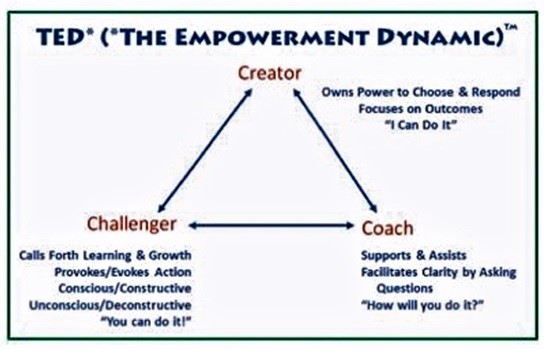Drama Triangle
How do you react in a stressful, emotional or conflict situation? How do your friends or family respond to such challenges? The Karpman Drama Triangle, also known as the Rescue Triangle, defines the common subconscious roles. And the resulting dysfunctional behaviours, we take on in these situations.
Dr Stephen Karpman, an expert in Transactional Analysis, defined the model in the 1960s. This shows the roles and dysfunctional interrelationships of people facing this sort of conflict situation.
Roles
The persecutor’s key messages are ‘I am OK, you’re not’, ‘It’s your fault’ and ‘I need to be in charge’. This involves blaming, labelling, criticism and putting others down. The payoff for them is that they get what they want. But this can leave them isolated and others feeling they can’t express themselves for fear of blame or criticism.

The victim’s key messages are ‘You are OK, I am not’, ‘I need help’ and ‘I can’t cope’. This involves complaining, withdrawal, being helpless and catastrophising. The payoff is that they don’t have to deal with things that are difficult or challenging, but can mean people avoid wanting to get involved and tire of helping.
The rescuer key messages are ‘I will help you’, ‘You don’t need to try’ and ‘I am better at this than you are’. This involves taking over, giving orders and fixing things. The payoff is that they feel liked, loved or appreciated, but this can lead to martyrdom and them becoming victims themselves.
Transformation
This is a useful model and realising where you are in the triangle is an important first step before ‘Moving on’ or ‘getting off the triangle’. There are two main ideas of how to transform and transcend this drama triangle.
In the 1990s the Drama Triangle model was extended with the TED (The Empowerment Dynamic) to include more positive roles and interaction to help people foster a more productive mind-set. These new roles show a more positive and helpful approach;
- The victim becomes the creator or owner. They become outcome-oriented as opposed to problem-oriented. They take responsibility and have the power to achieve a solution
- The persecutor becomes the challenger or motivator. They motivate the former victim to take action through supportive comments and actions.

- The rescuer becomes the coach or facilitator. They provide assistance and support, not the solutions as these need to be owned by the creator.
Conclusion
The main difference between the rescuer and the coach is that the coach sees the creator as capable of solving their own problems. The coach asks questions that enable the creator to see the possibilities for positive action and to concentrate on what they do want not what they don’t want.
As Eckhart Tolle (German-born spiritual teacher) said, “To complain is always nonacceptance of what is. It invariably carries an unconscious negative charge. When you complain, you make yourself into a victim. When you speak out, you are in your power. So change the situation by taking action or by speaking out if necessary or possible; leave the situation or accept it. All else is madness”.



Add a Comment